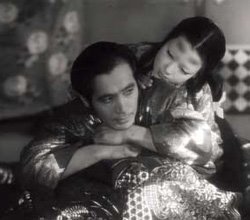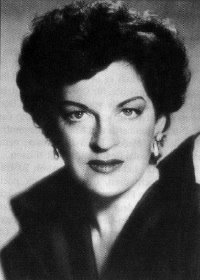
The great Swedish soprano Birgit Nilsson died on Christmas Day in her native Sweden. It was only today that her death was reported in America. She was one of the greatest stars of our times, memorable in the roles of Turandot, Tosca, and Aida. It was in the works of Richard Wagner, however, that she will be remembered as one of the immortals. During the late 1950's and '60's she was the world's leading Brünnhilde and Isolde, and her recording of
The Ring, conducted by Sir Georg Solti, (the first complete
Ring to be recorded in stereo) was a memorable landmark event.
I was very lucky to hear her live in Richard Strauss'
Elektra and
Die Frau ohne Schatten at the Metropolitan Opera when she made her triumphal return to America in the early 1980's. Although past her prime, those performances had an unforgettable electricity, and those of us who were lucky enough to get tickets for these performances will never forget them. You can read more about Birgit Nilsson career by visiting the
Wagnerian Sopranos section of Wagner Operas.
The following is the New York Times obituary:
STOCKHOLM, Sweden (AP) -- Birgit Nilsson, the farmer's daughter who became renowned in the world's great opera houses for her dazzling voice and among colleagues for her playful sense of humor, has died at age 87.
She died on Christmas Day, the Stockholm daily Svenska Dagbladet reported.
As word spread of her death two decades after she retired, the Swedish singer was remembered as one of the world's top Wagnerian sopranos.
''With Birgit Nilsson's passing, Sweden has lost one of its greatest artists,'' King Carl XVI Gustaf said in a rare statement.
''She was one of the greatest singers of the 20th century,'' said Menno Feenstra, artistic director at Stockholm's Royal Opera, who developed a close friendship with Nilsson after her retirement.
Feenstra called her vocal skills ''so solid and so 100 percent that you can hardly find a singer nowadays that has a technique like that.''
A funeral was held Wednesday at a church in her native town Vastra Karup in southern Sweden, with only her closest relatives attending, said Fredrik Westerlund, the church's vicar. He did not know when she died or the cause of death, but Nilsson was said to have had heart trouble in recent years.
Born on a farm, Nilsson reigned supreme at the world's opera houses during her career, which began in 1946 at the Stockholm Royal Opera as Agathe in Weber's ''Der Freischutz'' and continued until 1984.
She sang a wide variety of dramatic roles, but her reputation was based especially on her mastery of the most punishing in the repertory. Chief among these was Isolde in Wagner's ''Tristan und Isolde,'' which she sang for her sensational debut at New York's Metropolitan Opera on Dec. 18, 1959.
She was immediately hailed as a worthy successor to her fellow Scandinavian, Kirsten Flagstad, the Norwegian who owned the Wagner repertory at the Met during the years before World War II.
Other parts Nilsson made her own included Bruennhilde, the warrior maiden of Wagner's ''Ring'' cycle, the title role of Elektra in Richard Strauss' opera, and the heroine of Puccini's ''Turandot.''
''Birgit was unique!'' Met music director James Levine said in a statement. ''Her voice, her artistry, her sense of humor and her friendship were in a class of their own. I was so fortunate to hear her sing many times over the years, and eventually to work with her on several memorable occasions with Wagner and Strauss.''
''The thing that was remarkably wonderful about her was that she had no conceit. She was completely modest,'' Jon Vickers, her frequent Tristan, said in a telephone interview from his home in Bermuda.
At her peak, Nilsson astounded audiences in live performance with the unforced power of her voice, which easily cut through the thickest orchestrations, and with her remarkable breath control, which allowed her to hold onto the highest note for seemingly endless amounts of time. Her interpretive powers grew as her career developed, and she became a moving artist as well as a vocal phenomenon.
Her reputation in operatic lore was enhanced on Dec. 28, 1959, when she sang a performance of ''Tristan'' opposite three different tenors. Her scheduled co-star, Karl Liebel was ill, and so were his two ''covers,'' Ramon Vinay and Albert DaCosta. Met general manager Rudolf Bing perusaded each of them to go one for a single act so the performance wouldn't have to be canceled.
Nilsson also was renowned for her playful sense of humor. Once asked what was the chief requirement for singing Isolde, she replied: ''Comfortable shoes.''
Johanna Fiedler, in her book about the Met, ''Molto Agitato,'' tells the story of Nilsson's unhappiness with the gloomy lighting on which Herbert von Karajan insisted for his production of the ''Ring.'' To register her objections, she appeared on stage during a 1967 rehearsal of ''Die Walkuere'' wearing a coal miner's helmet with searchlight and wings.
''Karajan just looked at her, put his head down and conducted,'' Vickers recalled. ''He wouldn't look at her.''
Another legendary moment came after one of her frequent battle-of-the-high-note contests with tenor Franco Corelli during the second act duet from ''Turandot.'' Enraged that no matter how he tried she could hold onto the climactic high C longer than he could, Corelli apparently got his revenge during their third-act love scene by biting her on the neck instead of kissing her. Nilsson is said to have telephoned Bing to cancel her next performance with the explanation, ''I have rabies.''
Nilsson recalled the episode in an Oct. 30, 2003, phone interview with the AP following Corelli's death.
''He neither bit nor kissed me. It all ended appropriately in any case,'' she said.
Nilsson sang with the Met 222 times in 16 roles, making her finale at the October 1983 centennial gala. Her last appearance on the Met stage came more than a decade later, when she took part in an April 1996 gala celebrating Levine's 25th anniversary with the company. After some gracious remarks, she launched into Bruennhilde's ''ho-yo-to-ho'' battle cry from ''Walkuere,'' delivering -- at age 77 -- a performance that would have been the envy of any younger soprano.
Nilsson made her American debut at the San Francisco Opera on Oct. 5, 1956, as Bruennhilde, and sang at the Lyric Opera of Chicago from 1956-74. She sang Bruennhilde in the 1960s recording of Wagner's Ring Cycle with Sir Georg Solti and the Vienna Philharmonic, considered by many the definitive rendition.
She appeared 232 times at the Vienna State Opera from 1954-82, and the Vienna Philharmonic, the company's orchestra, made her an honorary member in 1999.
''If there ever was someone that one can call a real star today and a world-famous opera singer during her time then that was Frau Nilsson,'' said Ioan Holender, director of the Vienna State Opera.
Her music education started at age 3, when her mother, an accomplished amateur singer, bought Birgit a toy piano, on which she learned to pick out melodies.
''I sang before I could walk. I even sang in my dreams,'' she told reporters soon after her opera debut.
After retirement, she continued to teach master's level courses in singing.
Although she studied at Sweden's Royal Academy of Music, Nilsson said she learned most of her musical skills on her own.
''I'm mostly self-educated. I discovered early how wonderfully easy it was to sing in big localities. In small rooms my voice got tired,'' she told a Swedish reporter once.
Despite her worldwide recognition, Nilsson said she was nervous before every major performance.
''Before a premiere, on the way to the opera, I'd hope for just a small, small accident, it didn't need to be much, but just so I would not have to sing,'' she said in a 1977 interview on Swedish TV.
Nilsson married Swedish restaurateur Bertil Niklasson in 1949. The couple had no children.
------
Associated Press writers Mike Silverman and Ronald Blum in New York, Mattias Karen in Stockholm and George Jahn in Vienna, Austria, contributed to this report.
 American Song, the Thomas Hampson recital at Carnegie Hall last Thursday was a critical and popular success. It happened on the nineteenth of the month, that is, two days after Marilyn Horne's birthday. Two days after the concert itself, an audio capture of the event appeared posted on a Usenet group. The great baritone performed some of the best songs by Barber, Ives, Rorem, Thompson, and others. It was a carefully selected group of compositions, chosen and presented by Mr. Hampson with a didactic tone that seemed to work most of the time. At the conclusion of the show he offered two encores of incredible beauty: Stephen Foster's well-known "Beautiful Dreamer," and Haydn Wood's poignant "Roses of Picardy." It was towards the end of the program, right before he sang the Stephen Foster song that Mr. Hampson turned to the audience (as he did throughout the concert to explain and complain -- more about that later) and dedicated the Foster song to Marilyn Horne for her birthday. On the subject of American song, all singers owe a debt of gratitude to Marilyn Horne. Her album "Beautiful Dreamer, The Great American Songbook" with the English Chamber Orchestra under the great Carl Davis has done a lot to promote popular, serious American music. The fact that a day before Mr. Hampson's concert it was reported that the legendary mezzo-soprano was diagnosed with localized pancreatic cancer, added to the poignancy of Mr. Hampson's dedication. I'm not sure if Marilyn Horne was present at Carnegie Hall, but a friend who was at the concert told me that Mr. Hampson turned to the side when he dedicated the song, seemingly talking directly to someone.
American Song, the Thomas Hampson recital at Carnegie Hall last Thursday was a critical and popular success. It happened on the nineteenth of the month, that is, two days after Marilyn Horne's birthday. Two days after the concert itself, an audio capture of the event appeared posted on a Usenet group. The great baritone performed some of the best songs by Barber, Ives, Rorem, Thompson, and others. It was a carefully selected group of compositions, chosen and presented by Mr. Hampson with a didactic tone that seemed to work most of the time. At the conclusion of the show he offered two encores of incredible beauty: Stephen Foster's well-known "Beautiful Dreamer," and Haydn Wood's poignant "Roses of Picardy." It was towards the end of the program, right before he sang the Stephen Foster song that Mr. Hampson turned to the audience (as he did throughout the concert to explain and complain -- more about that later) and dedicated the Foster song to Marilyn Horne for her birthday. On the subject of American song, all singers owe a debt of gratitude to Marilyn Horne. Her album "Beautiful Dreamer, The Great American Songbook" with the English Chamber Orchestra under the great Carl Davis has done a lot to promote popular, serious American music. The fact that a day before Mr. Hampson's concert it was reported that the legendary mezzo-soprano was diagnosed with localized pancreatic cancer, added to the poignancy of Mr. Hampson's dedication. I'm not sure if Marilyn Horne was present at Carnegie Hall, but a friend who was at the concert told me that Mr. Hampson turned to the side when he dedicated the song, seemingly talking directly to someone.



